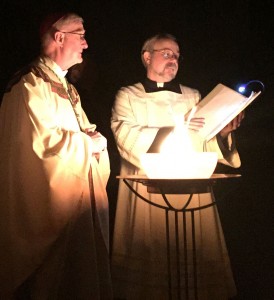Our Catholic liturgical observance of Easter begins with the Easter Vigil Service. It is the chief feast in the liturgical calendars of all Christian churches, commemorating Christ’s resurrection from the dead.
Bishop Martin Amos presided at the Easter Vigil Mass on April 4 at Sacred Heart Cathedral in Davenport and shares these reflections from his homily:

Bishop Martin Amos blesses the Easter fire at
the beginning of the Easter Vigil Mass April 4 at Sacred Heart Cathedral in Davenport. Also pictured is Deacon Frank Agnoli, diocesan director of liturgy and deacon formation.
“By definition a vigil is when one stays awake and watchful. By ancient tradition this is the night the Church keeps vigil for the Lord. This is the greatest and most noble of all solemnities,” Bishop Amos said.
“We have blessed the Easter fire and heard the Easter Proclamation, and now we have listened to nine readings from the Sacred Scriptures. We will soon welcome into full communion three people and renew our baptism promises. Finally, we will be called to the Lord’s Table, the memorial of his death and resurrection until he comes again.These nine readings from Scripture are the most solemn and important of the Liturgy of the Word in the Church’s entire liturgical year. And so this year I would like to spend a little time on them. The liturgy takes us way back to the beginning when God created the heavens and the earth, back to when God brought order out of chaos, back to the creation of humankind, ushering in a time of interconnectedness and harmony. And it was good, it was very good.
“Abraham, our father in faith, is tested and asked to sacrifice his own son, Isaac, a symbol of the Christ who carried the wood, the wood of the cross.
“Then, there is the Exodus and the Passover. For the Jewish people, it is the central event retold by them each year. For us, it is a sign of Jesus the new Paschal Lamb; our Passover from sin and death to life and freedom. But Isaiah reminds us that Israel was not always faithful, and God says: for a brief moment I abandoned you, but with great tenderness I will take you back.
“And then Isaiah invites all who are thirsty to come to the water, to seek the Lord where he may be found. The Prophet Baruch tells of forsaking wisdom and, as a result, making bad choices and then an appeal to embrace wisdom. The Old Testament readings end with Ezekiel’s promise of hope.
“St. Paul reminds us that through our baptism we were made a part of this salvation history, a part of Jesus’ Passover from death to life, being dead to sin and living for God in Christ Jesus.
The Liturgy of the Word ends with us finding the empty tomb.
“I have personally visited the empty tomb in Jerusalem on several occasions and said Mass in the tomb once. Finding it empty, our faith says with the young man clothed in a white robe: He has been raised; he is not here. But he does go before us where we will find him.
“The same God, who in the first reading created life and pronounced it very good, offers us now new life and it is very, very good.”











